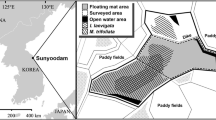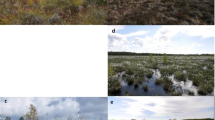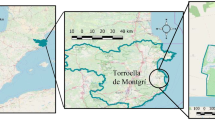Abstract
To understand the mechanism of how Phragmites australis makes valuable floating mat biotopes under oligotrophic conditions, we investigated the environmental (water chemistry) and vegetational characteristics (growth, plant species richness, and floristic composition) of a floating mat consisting of three main mat-forming species with a zonal distribution (P. australis on the land side of the floating mat, Zizania latifolia on the middle area, and Typha angustifolia on the water side). Although they showed relatively low growth in the floating mat, compared to those in land-based wetlands, P. australis grew better than other mat-forming species in terms of shoot height and biomass production. Specifically, P. australis made more below-ground parts (593 ± 38 g/m2) than other mat-forming species (Z. latifolia, 100 ± 10 g/m2; T. angustifolia, 167 ± 8 g/m2) and more companion species were found in P. australis-dominated plots (8.5 ± 1.0 species/m2) than other plots (Z. latifolia-dominated plots, 2.7 ± 0.6 species/m2; T. angustifolia-dominated plots, 1.0 ± 0.0 species/m2). The larger amount of below-ground P. australis parts could contribute to thicker and denser mat structures, possibly providing more favorable habitats for neighboring plant species, thus facilitating more companion species within the P. australis-dominated area of the mat.






Similar content being viewed by others
References
Asaeda T, Fujino T, Manatunge J (2005) Morphological adaptations of emergent plants to water flow: a case study with Typha angustifolia, Zizania latifolia and Phragmites australis. Freshw Biol 50:1991–2001
Asaeda T, Siong K, Kawashima T, Sakamoto K (2009) Growth of Phragmites japonica on a sandbar of regulated river: morphological adaptation of the plant to low water and nutrient availability in the substrate. River Res Appl 25:874–891
Azza N, Denny P, van de Koppel J, Kansiime F (2006) Floating mats: their occurrence and influence on shoreline distribution of emergent vegetation. Freshw Biol 51:1286–1297
Bellavance M-E, Brisson J (2010) Spatial dynamics and morphological plasticity of common reed (Phragmites australis) and cattails (Typha sp.) in freshwater marshes and roadside ditches. Aquat Bot 93:129–134
Byun C, Nam JM, Kim JG (2017) Effects of flooding regime on wetland plant growth and species dominance in a mesocosm experiment. Plant Ecol 218:517–527
Cherry JA, Gough L (2006) Temporary floating island formation maintains wetland plant species richness: the role of the seed bank. Aquat Bot 85:29–36
Chovanec A (1994) Man-made wetlands in urban recreational areas: a habitat for endangered species? Landsc Urban Plan 29:43–54
Chun Y-M, Choi YD (2009) Expansion of Phragmites australis (Cav.) Trin. ex Steud. (common reed) into Typha spp. (cattail) wetlands in Northwestern Indiana, USA. J Plant Biol 52:220–228
Colares GS, Dell’Osbel N, Wiesel PG, Oliveira GA, Lemos PHZ, da Silva FP, Lutterbeck CA, Kist LT, Machado ÊL (2020) Floating treatment wetlands: a review and bibliometric analysis. Sci Total Environ 714:136776
Coops H, Geilen N, Verheij HJ, Boeters R, van der Velde G (1996) Interactions between waves, bank erosion and emergent vegetation: an experimental study in a wave tank. Aquat Bot 53:187–198
Eisenlohr PV, Alves LF, Bernacci LC, Padgurschi MCG, Torres RB, Prata EMB, dos Santos FAM, Assis MA, Ramos E, Rochelle ALC, Marins FR, Campos MCR, Pedroni F, Sanchez M, Pereira LS, Vieira SA, Gomes JAMA, Tamashiro JY, Scaranello MAS, Caron CJ, Joly CA (2013) Disturbances, elevation, topography and spatial proximity drive vegetation patterns along an altitudinal gradient of a top biodiversity hotspot. Biodiv Conserv 22:2767–2783
Finlayson CM, van der Valk AG (1995) Wetland classification and inventory: a summary. Vegetation 118:185–192
Hernandez ME, Mitsch WJ (2007) Denitrification in created riverine wetlands: Influence of hydrology and season. Ecol Eng 30:78–88
Hogg EH, Wein RW (1988) The contribution of Typha components to floating mat buoyancy. Ecology 69:1025–1031
Hong MG, Kim JG (2012) Growth characteristics of cutting culms sectioned at different positions from three reed population. J Korean Soc Env Restor Technol 15:53–62
Hong MG, Kim JG (2016) Effects of initial density, nutrient, and water level regime on the seedling survival and growth of Typha orientalis Presl. J Plant Biol 59:369–376
Hong MG, Kim JG (2017) An analysis of trends in wetland function assessments and further suggestions. J Wetl Res 19:1–15
Hong MG, Son CY, Kim JG (2014) Effects of interspecific competition on the growth and competitiveness of five emergent macrophytes in a constructed lentic wetland. Paddy Water Environ 12:S193–S202
Hong MG, Nam BE, Kim JG (2018) Vegetation and water characteristics of floating mat in a coastal lagoon as the habitat for endangered plant species. J Ecol Environ 42:28
Hong MG, Park H, Nam BE, Kim JG (2019) Vegetational characteristics of abandoned paddy terraces in comparison with natural and constructed wetlands. J Wetl Res 21:199–206
Hung LQ, Asaeda T, Fujino T, Mnaya BJ (2007) Inhibition of Zizania latifolia growth by Phragmites australis: an experimental study. Wetl Ecol Manag 15:105–111
Jeon SH, Kim H, Nam JM, Kim JG (2013) Habitat characteristics of sweet flag (Acorus calamus) and their relationship with biomass. Landsc Ecol Eng 9:67–75
Kamphake LJ, Hannah SA, Cohen JM (1967) Automated analysis for nitrate by hydrazine reduction. Water Res 1:205–216
Karstens S, Jurasinski G, Glatzel S, Buczko U (2016) Dynamics of surface elevation and microtopography in different zones of a coastal Phragmites wetland. Ecol Eng 94:152–163
Kim HT, Lee GM, Kim JG (2013) The ecological characteristics and conservation counterplan of Menyanthes trifoliata habitat in floating mat in Korean east coastal lagoon, Sunyoodam. J Wetl Res 15:25–34
Končalová H (1990) Anatomical adaptations to waterlogging in roots of wetland graminoids: limitations and drawbacks. Aquat Bot 38:127–134
Lee TB (2003) Colored flora of Korea. Hyangmunsa, Seoul
Lee K, Jang J, Kim Y, Park B (1999) A study on the floating island for water quality improvement of a reservoir. Korean J Environ Agric 18:77–82
Lee EH, Lee BE, Kim JG (2018) Effects of water levels and soil nutrients on the growth of Iris laevigata seedlings. J Ecol Environ 42:5
Liyama N, Kamada M, Nakagoshi N (2005) Ecological and social evaluation of landscape in a rural area with terraced paddies in southwestern Japan. Landsc Urban Plan 70:301–313
Long AL, Kettenring KM, Hawkins CP, Neale CMU (2017) Distribution and drivers of a widespread, invasive wetland grass, Phragmites australis, in wetlands of the Great Salt Lake, Utah, USA. Wetlands 37:45–57
Lupien NG, Gauthier G, Lavoie C (2015) Effect of the invasive common reed on the abundance, richness and diversity of birds in freshwater marshes. Anim Conserv 18:32–43
Magee TK, Kentula ME (2005) Response of wetland plant species to hydrologic conditions. Wetl Ecol Manag 13:163–181
Mallison GT, Stocker RK, Cichra CE (2001) Physical and vegetative characteristics of floating islands. J Aquat Plant Manage 39:107–111
McLaughlin DL, Cohen MJ (2013) Realizing ecosystem services: wetland hydrologic function along a gradient of ecosystem condition. Ecol Appl 23:1619–1631
Mitsch WJ, Gosselink JG (2000) The value of wetlands: importance of scale and landscape setting. Ecol Econ 35:25–33
Murphy J, Riley JP (1962) A modified single solution method for the determination of phosphate in natural waters. Anal Chim Acta 27:31–36
Nam JM, Yoon J, Kim H, Kim JG (2008) Plant settlement patterns and their effects on breeding sites of little terns (Sterna albifrons) on sand bars on Ganwol Lake. J Ecol Field Biol 31:37–43
Nam JM, Jeon SH, Choi H, Kim JG (2014) Effects of micro-topography on vegetation pattern in Dunchon-dong wetland. J Wetl Res 16:353–362
Nam BE, Kim JG, Hong MG (2018) Vegetation and water characteristics of an eco-technological water purifying biotope in Yongin. J Wetl Res 20:432–445
Park J, Hong MG, Kim JG (2013) Relationship between early development of plant community and environmental condition in abandoned paddy terraces at mountainous valleys in Korea. J Ecol Environ 36:131–140
Pavlineri N, Skoulikidis NT, Tsihrintzis VA (2017) Constructed floating wetlands: a review of research, design, operation and management aspects, and data meta-analysis. Chem Eng J 308:1120–1132
Sarneel JM (2013) The dispersal capacity of vegetative propagules of riparian fen species. Hydrobiologia 710:219–225
Sharma P, Asaeda T, Fujino T (2008) Effect of water depth on the rhizome dynamics of Typha angustifolia. Wetl Ecol Manag 16:43–49
Sheng Q, Wang L, Wu J (2015) Vegetation alters the effects of salinity on greenhouse gas emissions and carbon sequestration in a newly created wetland. Ecol Eng 84:542–550
Shin CJ, Kim JG (2013) Ecotypic differentiation in seed and seedling morphology and physiology among Cicuta virosa populations. Aquat Bot 111:74–80
Shin CJ, Nam JM, Kim JG (2015) Floating mat as a habitat of Cicuta virosa, a vulnerable hydrophyte. Landsc Ecol Eng 11:111–117
Silliman BR, Bertness MD (2004) Shoreline development drives invasion of Phragmites australis and the loss of plant diversity on New England salt marshes. Conserv Biol 18:1424–1434
Solorzano L (1969) Determination of ammonia in natural waters by the phenol hypochlorite method. Limnol Oceanogr 14:799–801
Tanner CC (1996) Plants for constructed wetland treatment systems—a comparison of the growth and nutrient uptake of eight emergent species. Ecol Eng 7:59–83
Tsujino R, Fujita N, Katayama M, Kawase D, Matsui K, Seo A, Shimamura T, Takemon Y, Tsujimura N, Yumoto T, Ushimaru A (2010) Restoration of floating mat bog vegetation after eutrophication damages by improving water quality in a small pond. Limnology 11:289–297
Vretare V, Weisner SEB (2000) Influence of pressurized ventilation on performance of an emergent macrophyte (Phragmites australis). J Ecol 88:978–987
Wallis E, Raulings E (2011) Relationship between water regime and hummock-building by Melaleuca ericifolia and Phragmites australis in a brackish wetland. Aquat Bot 95:182–188
Wang CY, Sample DJ, Day SD, Grizzard TJ (2015) Floating treatment wetland nutrient removal through vegetation harvest and observations from a field study. Ecol Eng 78:15–26
Yamasaki S (1984) Role of plant aeration in zonation of Zizania latifolia and Phragmites australis. Aquat Bot 18:287–297
Yamasaki S, Tange I (1981) Growth responses of Zizania latifolia, Phragmites australis, and Miscanthus sacchariflorus to varying inundation. Aquat Bot 10:229–239
Yang YY, Kim JG (2019) Changes in reproductive strategy of an early successional species Penthorum chinense in response to nutrient and moisture levels. J Plant Biol 62:103–108
Yao K, Song S, Zhang Z, Xu J, Zhang R, Liu J, Cheng L, Liu J (2011) Vegetation characteristics and water purification by artificial floating island. Afr J Biotechnol 10:19119–19125
Acknowledgements
We would like to thank So Jung Min in Seoul National University for advising and supporting in the field survey. This research was supported by Basic Science Research Program (NRF-2015R1D1A1A01057373) through the National Research Foundation of Korea funded by the Ministry of Education and by the National Research Foundation of Korea grant (NRF-2018R1A2B2002267) funded by the Korea government of Ministry of Science and ICT. All experiments performed in this study complied with current laws of the Republic of Korea.
Author information
Authors and Affiliations
Corresponding author
Supplementary Information
Below is the link to the electronic supplementary material.
Rights and permissions
About this article
Cite this article
Hong, M.G., Nam, B.E. & Kim, J.G. Phragmites australis makes valuable floating mat biotopes under oligotrophic conditions. Landscape Ecol Eng 17, 109–118 (2021). https://doi.org/10.1007/s11355-020-00440-9
Received:
Revised:
Accepted:
Published:
Issue Date:
DOI: https://doi.org/10.1007/s11355-020-00440-9




